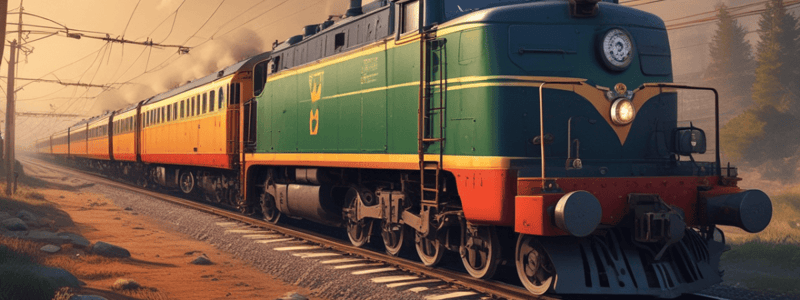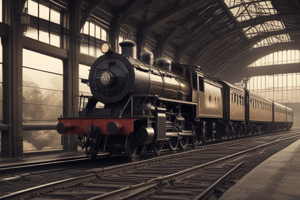Podcast
Questions and Answers
What was the name of the person who opposed the first steam railway proposal for London in 1825?
What was the name of the person who opposed the first steam railway proposal for London in 1825?
- Isambard Kingdom Brunel
- Richard Trevithick
- George Stevenson
- George Shillibeer (correct)
What was the main challenge faced in constructing the London & Greenwich Railway?
What was the main challenge faced in constructing the London & Greenwich Railway?
- Obtaining approval from the public
- Traversing a built-up area (correct)
- Funding for the project
- Lack of skilled workers
How many bricks were estimated to be laid for the construction of the viaduct?
How many bricks were estimated to be laid for the construction of the viaduct?
- 50 million
- 60 million (correct)
- 30 million
- 40 million
What was the first task undertaken for the construction of the railway?
What was the first task undertaken for the construction of the railway?
What was the name given to the workers who had previously built canals and were employed for railway construction?
What was the name given to the workers who had previously built canals and were employed for railway construction?
How were the navvies divided during the construction of the railway?
How were the navvies divided during the construction of the railway?
What was the initial method used for laying the track for the railway?
What was the initial method used for laying the track for the railway?
During which period was the cholera outbreak raging in the area where the survey for the railway line was conducted?
During which period was the cholera outbreak raging in the area where the survey for the railway line was conducted?
What was the name of the company that received the Act to construct the London & Greenwich Railway?
What was the name of the company that received the Act to construct the London & Greenwich Railway?
In what year was the first steam railway for London proposed?
In what year was the first steam railway for London proposed?
The first steam railway for London was proposed in 1835.
The first steam railway for London was proposed in 1835.
The London & Greenwich Railway Company was formed in 1833.
The London & Greenwich Railway Company was formed in 1833.
The route for the London & Greenwich Railway was planned to be constructed at street level.
The route for the London & Greenwich Railway was planned to be constructed at street level.
The viaduct for the London & Greenwich Railway had 878 stone arches.
The viaduct for the London & Greenwich Railway had 878 stone arches.
The navvies who worked on the railway were originally canal builders known as navigators.
The navvies who worked on the railway were originally canal builders known as navigators.
The two areas where the navvies worked were called Irish Grounds and Scottish Grounds.
The two areas where the navvies worked were called Irish Grounds and Scottish Grounds.
The track for the London & Greenwich Railway was originally laid with rails spiked to wooden blocks.
The track for the London & Greenwich Railway was originally laid with rails spiked to wooden blocks.
The workers had to survey the line through the affluent neighborhoods of Bermondsey.
The workers had to survey the line through the affluent neighborhoods of Bermondsey.
The proposal to build the railway over the streets and houses was met with immediate public approval.
The proposal to build the railway over the streets and houses was met with immediate public approval.
The first person to oppose the steam railway proposal was George Shillibeer.
The first person to oppose the steam railway proposal was George Shillibeer.
Who proposed the first steam railway for London in 1825?
Who proposed the first steam railway for London in 1825?
What was the main challenge faced if the London & Greenwich Railway was constructed at street level?
What was the main challenge faced if the London & Greenwich Railway was constructed at street level?
What was the initial method used for laying the track for the London & Greenwich Railway?
What was the initial method used for laying the track for the London & Greenwich Railway?
What were the two areas where the navvies worked during the construction of the railway called?
What were the two areas where the navvies worked during the construction of the railway called?
What was the first task undertaken for the construction of the London & Greenwich Railway?
What was the first task undertaken for the construction of the London & Greenwich Railway?
How many brick arches were required for the viaduct of the London & Greenwich Railway?
How many brick arches were required for the viaduct of the London & Greenwich Railway?
During which period was the cholera outbreak raging in the area where the survey for the railway line was conducted?
During which period was the cholera outbreak raging in the area where the survey for the railway line was conducted?
What were the workers who had previously built canals and were employed for railway construction known as?
What were the workers who had previously built canals and were employed for railway construction known as?
What was the name of the company that was formed in 1831 to construct the London & Greenwich Railway?
What was the name of the company that was formed in 1831 to construct the London & Greenwich Railway?
In what year was the London & Greenwich Railway Company granted its Act?
In what year was the London & Greenwich Railway Company granted its Act?
The first steam railway for London was proposed in ______ and one of those who opposed the scheme was George Shillibeer
The first steam railway for London was proposed in ______ and one of those who opposed the scheme was George Shillibeer
The London & Greenwich Railway Company was formed in ______ and received its Act in 1833
The London & Greenwich Railway Company was formed in ______ and received its Act in 1833
The route for the London & Greenwich Railway led across a built-up area, so it was decided to build it over the streets and houses on a ______ with 878 brick arches
The route for the London & Greenwich Railway led across a built-up area, so it was decided to build it over the streets and houses on a ______ with 878 brick arches
The workers who had built canals and were later employed for railway construction were known as ______
The workers who had built canals and were later employed for railway construction were known as ______
The task of surveying the line for the railway was undertaken through the slums of ______
The task of surveying the line for the railway was undertaken through the slums of ______
The workers who had previously built canals and were employed for railway construction were known as navigators, later shortened to ______
The workers who had previously built canals and were employed for railway construction were known as navigators, later shortened to ______
The workers had to lay an estimated 60 million ______ for the viaduct
The workers had to lay an estimated 60 million ______ for the viaduct
The track for the London & Greenwich Railway was originally laid with rails spiked to ______ blocks
The track for the London & Greenwich Railway was originally laid with rails spiked to ______ blocks
The two areas where the navvies worked during the construction of the railway were known as English Grounds and ______ Grounds
The two areas where the navvies worked during the construction of the railway were known as English Grounds and ______ Grounds
The workers who built canals and were later employed for railway construction were known as navigators, later shortened to navvies, and were available to use their strength and expertise for the ______ builders
The workers who built canals and were later employed for railway construction were known as navigators, later shortened to navvies, and were available to use their strength and expertise for the ______ builders
Match the following terms with their meanings:
Match the following terms with their meanings:
Match the following locations with their descriptions:
Match the following locations with their descriptions:
Match the following individuals with their roles in the railway history:
Match the following individuals with their roles in the railway history:
Match the following features with their characteristics:
Match the following features with their characteristics:
Match the following challenges with their corresponding solutions:
Match the following challenges with their corresponding solutions:
Flashcards are hidden until you start studying



